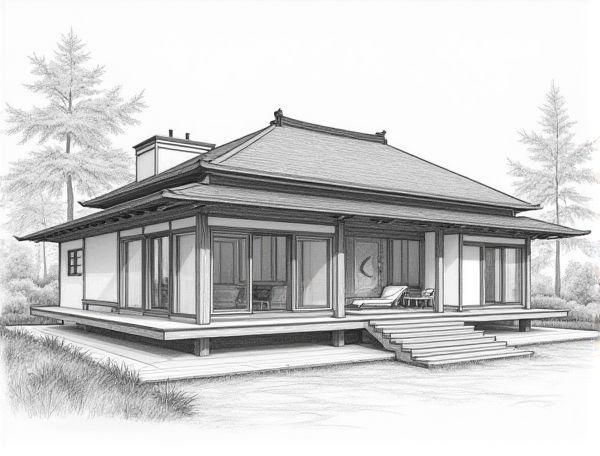
Photo illustration: Japanese Sukiya home design with tokonoma alcove
Experience the serene elegance of Japanese Sukiya home design, where natural materials and minimalist aesthetics create harmonious living spaces centered around the iconic tokonoma alcove--a recessed area that showcases art, flowers, or calligraphy, enriching your home's cultural ambiance. Discover how incorporating a tokonoma can transform your interior into a tranquil retreat by exploring more in the full article.
Introduction to Japanese Sukiya Home Design
Japanese Sukiya home design emphasizes simplicity, natural materials, and harmonious integration with the environment. Characterized by clean lines, exposed wooden beams, and tatami mat flooring, Sukiya style reflects traditional tea house aesthetics adapted for modern living spaces. The use of shoji screens and sliding doors enhances spatial fluidity and maximizes natural light within the home.
Historical Origins of Sukiya Architecture
Sukiya architecture, originating in 16th-century Japan, reflects the aesthetic principles of the tea ceremony pioneered by Sen no Rikyu, emphasizing simplicity, natural materials, and harmonious integration with the surrounding environment. This architectural style incorporates elements such as tatami flooring, shoji screens, and wooden beams to create intimate, meditative spaces that foster contemplation and connection with nature.
Key Elements of Sukiya Style Interiors
Sukiya style interiors emphasize natural materials such as wood and bamboo, creating a harmonious balance between simplicity and elegance that reflects traditional Japanese aesthetics. Your design should incorporate tatami mats, shoji screens, and subtle earthy color palettes to achieve an authentic, serene atmosphere that promotes mindfulness and connection with nature.
The Role and Significance of the Tokonoma Alcove
The Tokonoma alcove serves as a focal point in traditional Japanese home design, showcasing art, flower arrangements, or calligraphy that reflects the homeowner's aesthetic values and cultural appreciation. Its placement and decor influence the ambiance and harmony of the living space, embodying principles of wabi-sabi and enhancing the room's overall balance.
Materials and Natural Elements in Sukiya Homes
Sukiya homes emphasize the integration of natural materials such as untreated wood, bamboo, and clay, creating a harmonious connection between indoor spaces and the surrounding environment. The careful selection of these sustainable materials enhances durability and aesthetic appeal while promoting eco-friendly living. Incorporating tatami mats, shoji screens, and natural stone further accentuates the minimalist design ethos and traditional Japanese craftsmanship characteristic of Sukiya architecture.
Harmony with Nature and Indoor-Outdoor Flow
Creating a home design that emphasizes harmony with nature integrates natural materials, ample daylight, and native landscaping, fostering a seamless indoor-outdoor flow that enhances well-being and sustainability. Large glass doors, open floor plans, and strategically placed windows blur boundaries, promoting natural ventilation and a continuous connection to the surrounding environment.
Minimalism and Zen Aesthetics in Sukiya Design
Sukiya design merges minimalism and Zen aesthetics by emphasizing natural materials, clean lines, and balanced spatial arrangements to create serene, uncluttered living spaces. This approach fosters harmony and mindfulness, integrating elements like tatami floors and shoji screens to enhance simplicity and tranquility.
Placement and Decorating Ideas for Tokonoma
Tokonoma placement requires a strategic spot in your living or tea room where it becomes a natural focal point, enhancing the overall harmony and aesthetic balance. Decorating your tokonoma with seasonal scrolls, ikebana flower arrangements, or carefully chosen ceramics brings a timeless cultural touch that reflects your personal style. Your home's ambiance benefits significantly by maintaining minimal clutter around the tokonoma, allowing its artistic elements to shine and create a serene, inviting atmosphere.
Integrating Sukiya Features in Modern Homes
Incorporating Sukiya architecture into modern homes emphasizes natural materials, asymmetrical layouts, and seamless indoor-outdoor connectivity, enhancing both aesthetic appeal and tranquility. Elements such as shoji screens, tatami mats, and wooden beams create a minimalist yet warm environment, blending traditional Japanese craftsmanship with contemporary functionality.
Tips for Creating Authentic Sukiya with Tokonoma
Incorporate natural materials like wood and bamboo to enhance the authentic Sukiya aesthetic, emphasizing simplicity and refined craftsmanship. Position the Tokonoma alcove thoughtfully to showcase seasonal art or flower arrangements, creating a focal point that embodies tranquility and cultural significance. Your choice of subtle, earthy colors and minimalist decor will harmonize the space, reflecting the elegance and understated beauty characteristic of traditional Japanese design.
 homedesy.com
homedesy.com